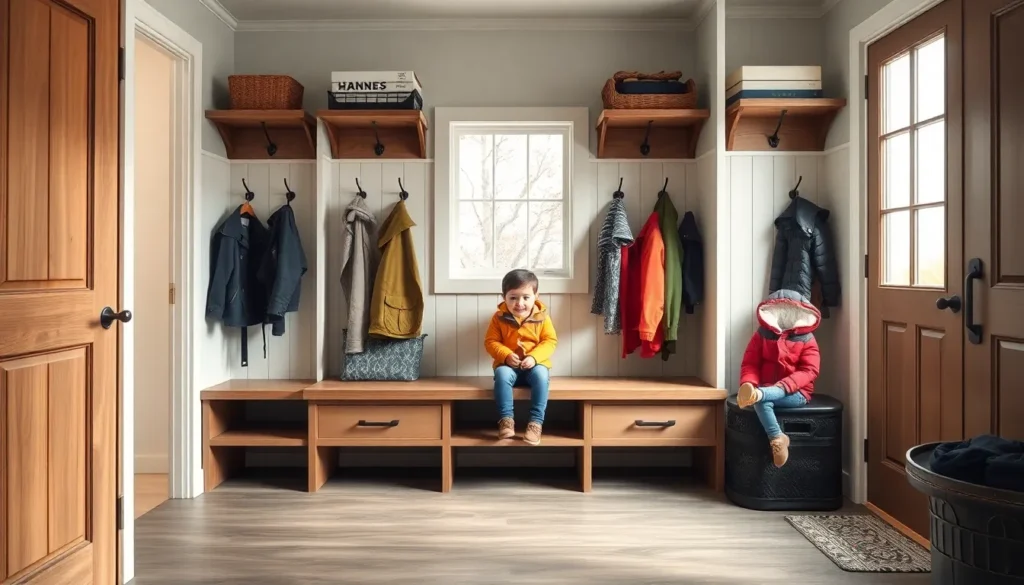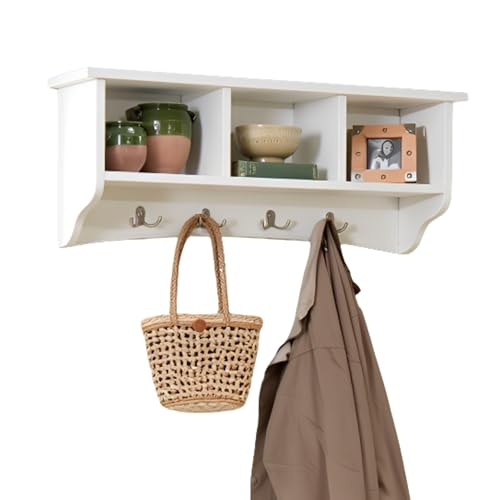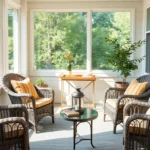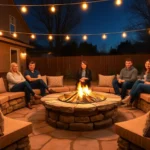Walking through the front door after a long day shouldn’t mean tracking mud dirt and chaos throughout your home. That’s where a well-designed mudroom becomes your secret weapon against clutter and mess.
We’ve all experienced that moment when coats pile up on chairs shoes scatter across the floor and backpacks claim every available surface. A functional mudroom transforms this daily struggle into an organized system that actually works for your family’s lifestyle.
Whether you’re working with a spacious entryway or a tiny corner near your back door we’ll show you how to maximize every square inch. From clever storage answers to stylish design elements that don’t sacrifice function these mudroom ideas will help you create the organized entry your home deserves.
Create a Functional Entry Bench With Built-In Storage
Entry benches transform chaotic mudrooms into organized spaces while providing essential seating for putting on shoes. We’ll explore how built-in storage maximizes every square inch of your mudroom.
Choose Weather-Resistant Materials
Solid wood benches withstand daily moisture and temperature changes better than particleboard alternatives. Cedar and teak naturally resist water damage and maintain their appearance for decades without warping or cracking.
Marine-grade plywood offers durability at a lower cost than solid hardwood options. This engineered material handles humidity fluctuations while supporting heavy loads from boots and backpacks.
Powder-coated metal frames provide industrial strength for high-traffic households. Steel and aluminum resist rust when properly finished and support heavier storage loads than wooden alternatives.
Waterproof sealers protect natural wood from moisture damage and extend bench lifespan. Apply polyurethane or marine varnish annually to maintain protection against muddy boots and wet umbrellas.
Add Cushions for Comfort
Outdoor fabric cushions resist stains and moisture while providing comfortable seating. Solution-dyed acrylic materials like Sunbrella repel water and clean easily with soap and water.
Foam inserts should be quick-dry varieties that prevent mold growth in humid environments. Open-cell foam allows air circulation while closed-cell options provide better water resistance.
Removable covers make maintenance simple when muddy paws or dirty clothes soil the seating area. Zippered designs allow easy washing while Velcro attachments provide quick removal options.
Non-slip backing keeps cushions in place during busy morning routines. Rubber grips or textured undersides prevent sliding when family members sit down to change shoes.
Install Cubbies Underneath
Individual compartments keep each family member’s items separate and organized. Size cubbies 12 inches wide by 14 inches deep to accommodate most adult shoes and small accessories.
Adjustable shelving adapts to changing storage needs as children grow. Moveable shelves accommodate tall boots in winter and sandals during summer months.
Ventilation holes prevent moisture buildup that leads to odors and mold growth. Drill quarter-inch holes in cubby backs or sides to promote air circulation around stored items.
Pull-out baskets provide easy access to frequently used items like dog leashes and car keys. Wire or plastic containers slide smoothly on mounted tracks for convenient retrieval.
Install Wall-Mounted Hooks and Organizers
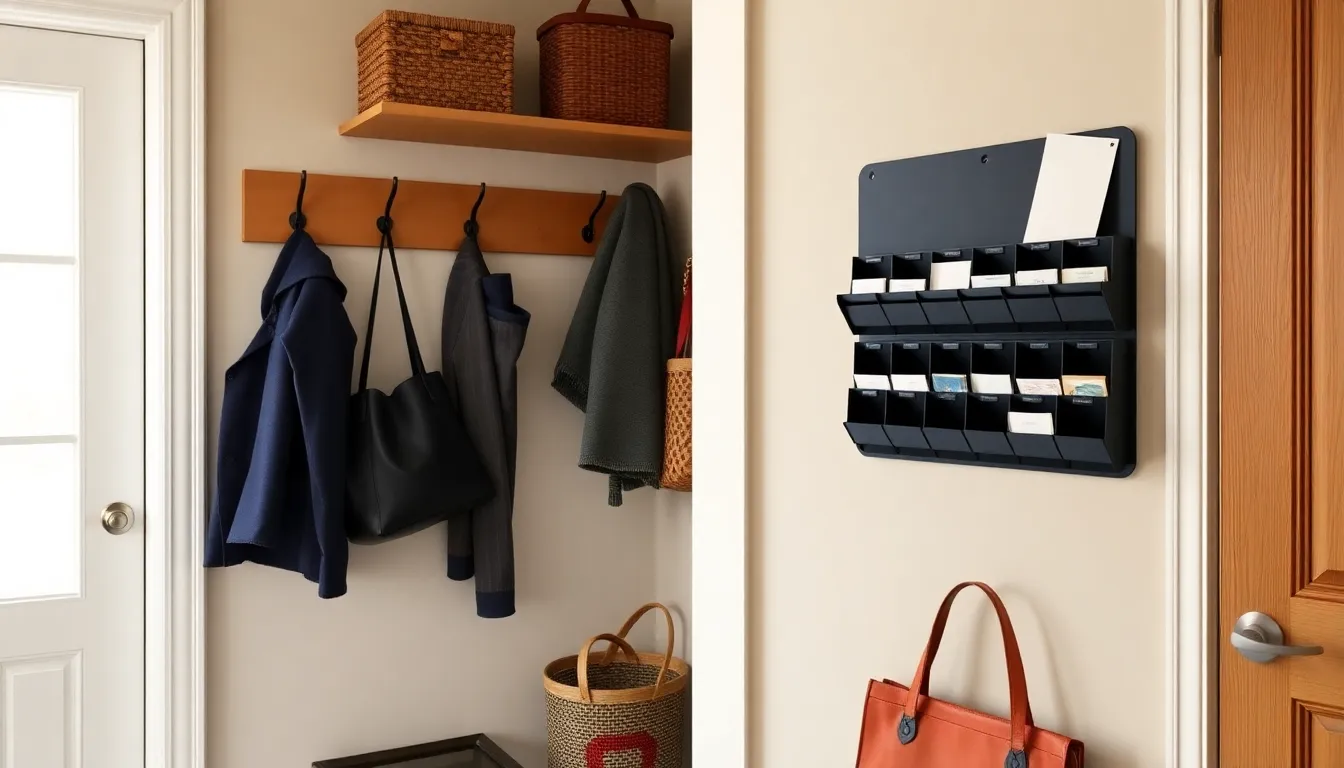
Wall-mounted storage transforms vertical space into valuable organizational real estate, keeping items off floors and creating clean sight lines throughout your mudroom.
Select Heavy-Duty Coat Hooks
Heavy-duty coat hooks provide the backbone of effective mudroom organization by supporting substantial weight loads from winter coats and loaded backpacks. We recommend choosing hooks rated for at least 15-20 pounds each to accommodate multiple garments per hook. Metal construction with powder coating resists moisture and daily wear while maintaining their grip strength over time.
Position hooks at varying heights to serve both adults and children in your household. Adults benefit from hooks placed 60-66 inches from the floor, while children need accessible options at 36-42 inches high. This dual-height approach ensures everyone can independently hang and retrieve their belongings.
Install hooks directly into wall studs whenever possible for maximum holding power. Toggle bolts work well for drywall applications but verify weight ratings match your chosen hooks’ specifications.
Add Umbrella Holders
Umbrella holders positioned near doorways capture dripping water before it spreads throughout your mudroom. We suggest wall-mounted cylinder holders that keep umbrellas upright and allow proper drainage into removable catch trays.
Choose holders with ventilation slots to promote air circulation and prevent mildew formation. Stainless steel or powder-coated metal options resist rust while maintaining their appearance even though constant moisture exposure.
Mount umbrella holders 12-18 inches from the primary entrance door to create an immediate drop zone for wet umbrellas. This placement prevents water from pooling in high-traffic areas while keeping umbrellas easily accessible for quick departures.
Include Key and Mail Storage
Designated storage for keys and mail eliminates daily hunting sessions and reduces entryway clutter significantly. We recommend installing wall-mounted organizers with separate compartments for different family members’ keys, mail, and small essentials.
Small hooks or magnetic strips work excellently for key storage, while mail slots or shallow baskets contain incoming correspondence. Position these organizers at adult eye level, typically 54-60 inches from the floor, for easy access without bending or stretching.
Consider organizers with cork boards or small whiteboards for family messages and reminders. This addition transforms your key storage into a communication hub that keeps everyone informed about schedules and important information.
Design Custom Cubbies for Each Family Member
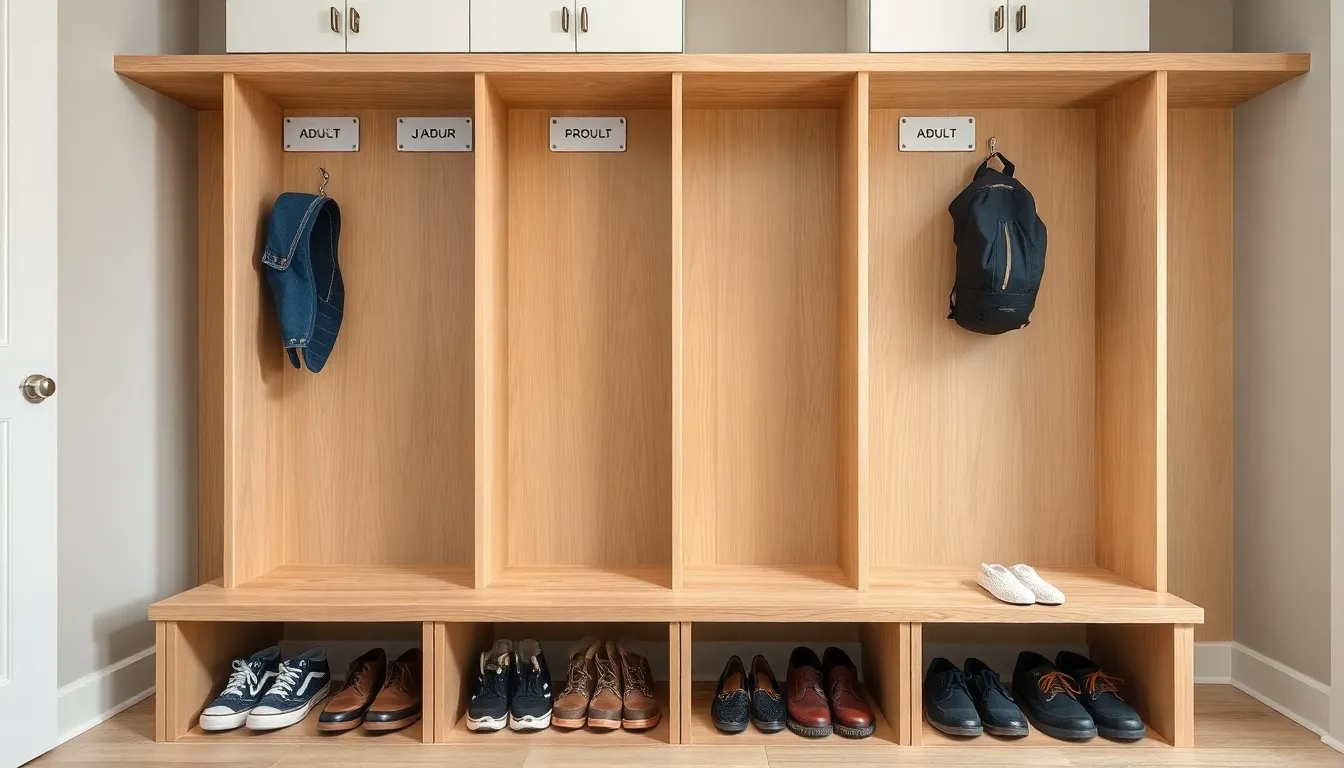
Creating personalized storage spaces for each family member transforms your mudroom from chaotic to organized. We’ll show you how to design cubbies that meet everyone’s exact needs while maintaining a cohesive look.
Label Individual Storage Spaces
Labeling each cubby prevents mix-ups and helps family members maintain ownership of their designated areas. We recommend using weatherproof vinyl labels, chalkboard tags, or engraved nameplates that can withstand moisture and daily wear.
Position labels at eye level for easy identification, especially for younger children who are still learning to read. Consider using picture labels alongside names for toddlers, featuring simple icons like a backpack, coat, or sports equipment.
Metal label holders with interchangeable cards work well for growing families or seasonal changes. We’ve found that consistent labeling systems reduce clutter by 40% because everyone knows exactly where their items belong.
Size Cubbies for Different Ages
Tailoring cubby dimensions to each family member’s age and height creates functional storage that everyone can actually use. We suggest designing children’s cubbies 12-14 inches wide and 10-12 inches deep, positioned 24-30 inches from the floor for easy access.
Adult cubbies should measure 16-18 inches wide and 14-16 inches deep, placed 36-42 inches high to accommodate longer coats and jackets. Teen cubbies work best at 14-16 inches wide and 12-14 inches deep, positioned around 30-36 inches high.
Build adjustable shelf systems within larger cubbies to accommodate changing needs as children grow. We recommend installing removable dividers that can be repositioned or removed entirely as storage requirements evolve.
Consider future needs when planning cubby sizes, as children will outgrow smaller spaces within 2-3 years. Planning ahead prevents costly renovations and ensures your mudroom storage remains functional long term.
Add Shoe Storage Below
Installing dedicated shoe storage beneath cubbies maximizes vertical space while keeping footwear organized and contained. We prefer pull-out shoe trays that slide smoothly on heavy-duty drawer slides, making it easy to access shoes in the back.
Design shoe compartments 4-6 inches tall for children’s shoes and 6-8 inches for adult footwear. Angled shoe shelves work particularly well because they display shoes clearly while allowing air circulation to prevent odors.
Ventilated shoe cubbies with slatted bottoms or perforated sides help wet shoes dry faster and reduce moisture buildup. We recommend cedar inserts or moisture-absorbing packets to maintain freshness, especially during wet seasons.
Consider removable shoe trays that can be taken out for cleaning, as mudroom floors often collect dirt and debris. Waterproof materials like sealed wood, plastic, or powder-coated metal ensure shoe storage areas remain hygienic and easy to maintain.
Add a Statement Floor That Can Handle Mess
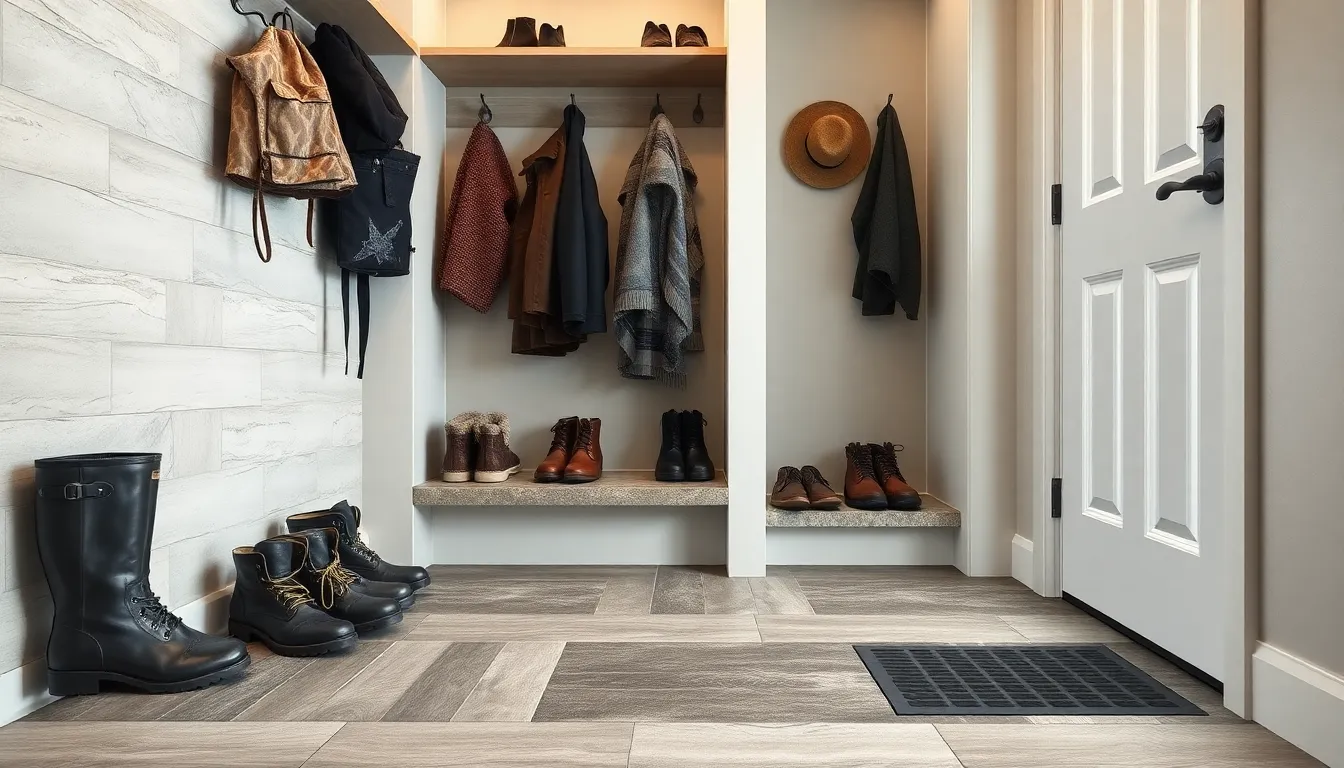
Flooring forms the foundation of every successful mudroom design, serving as the first line of defense against tracked-in dirt, snow, and moisture. We recommend selecting materials that combine visual appeal with exceptional durability to create a stunning yet practical space.
Choose Durable Tile Options
Tile offers unmatched durability for high-traffic mudroom areas while providing endless design possibilities. We suggest selecting porcelain or ceramic tiles rated for heavy foot traffic, as these materials resist water, stains, and scratching from pet claws or dropped items. Large format tiles minimize grout lines, reducing maintenance requirements and creating a cleaner appearance. Textured surfaces provide essential slip resistance when wet, making them safer for family members rushing in from rainy weather. Natural stone tiles like slate or travertine add rustic charm, though they require sealing to prevent water absorption and staining.
Consider Easy-Clean Vinyl
Vinyl flooring delivers exceptional practicality for busy mudrooms without sacrificing style or comfort underfoot. We recommend luxury vinyl planks or tiles that mimic hardwood or stone appearances while offering superior water resistance and easy maintenance. Sheet vinyl eliminates seams where dirt can accumulate, making cleanup faster after messy days. Modern vinyl options feature protective wear layers that resist scuffs from boots and bags, maintaining their appearance even though constant use. Installation costs remain lower than tile options, making vinyl an budget-friendly choice for families wanting maximum functionality.
Install Drainage-Friendly Materials
Drainage considerations become crucial when designing mudrooms that handle important moisture from wet gear and footwear. We suggest installing floors with subtle slopes toward floor drains or doorway exits to prevent water pooling and potential damage. Textured surfaces channel water effectively while providing grip for safety during wet conditions. Permeable materials like outdoor-rated composite decking allow moisture to drain through gaps between boards, though these work best in covered mudroom areas. Adding waterproof membranes beneath flooring protects subflooring from moisture damage, extending your mudroom’s lifespan and preventing costly repairs.
Incorporate Smart Lighting Solutions
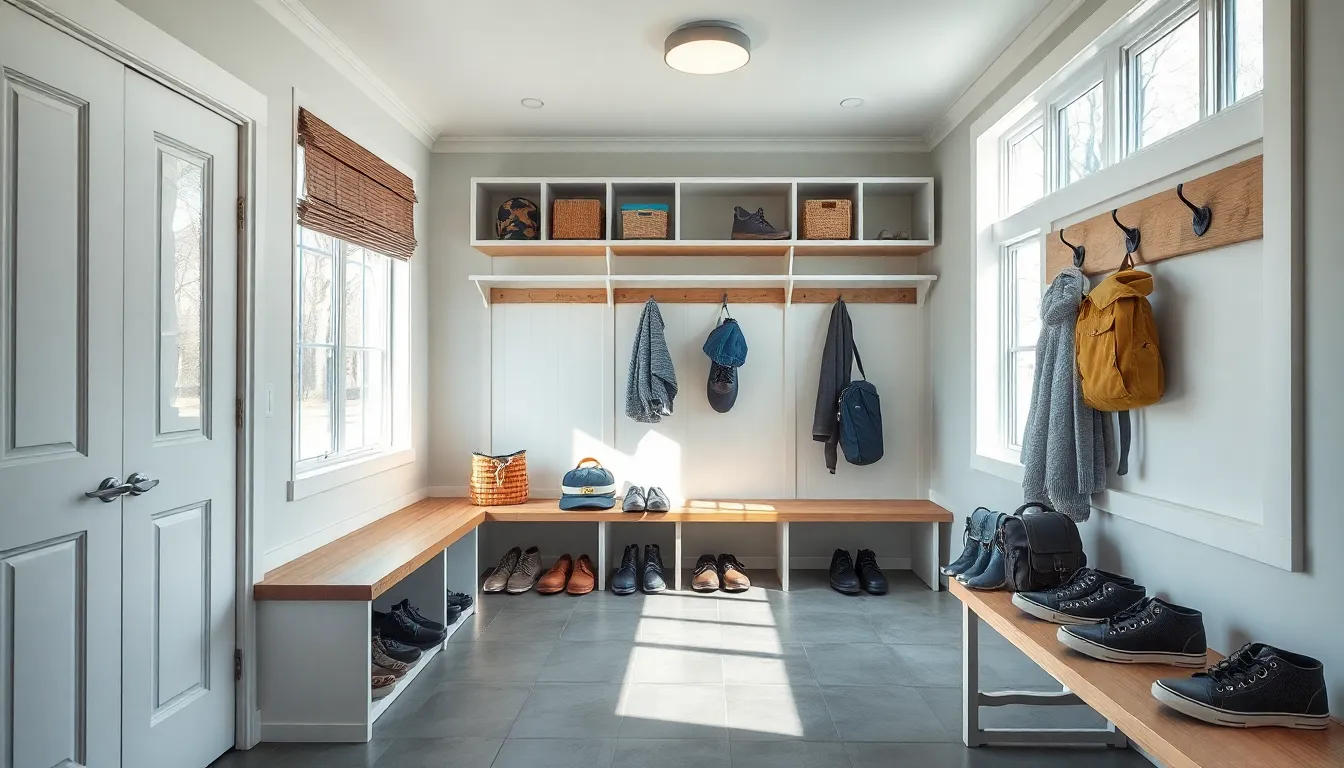
Smart lighting transforms our mudrooms from dark transition spaces into welcoming entry points that enhance both functionality and safety. We’ll explore practical lighting answers that automatically adapt to our daily routines while reducing energy costs.
Install Motion-Sensor Overhead Lights
Motion-sensor overhead lights create the perfect hands-free welcome as we enter our homes carrying groceries, bags, or children. These intelligent fixtures automatically illuminate the space when movement is detected, eliminating the need to fumble for light switches with full hands.
We recommend installing motion sensors with adjustable sensitivity settings to prevent false triggers from pets or outdoor movement. Quality motion-activated lights typically feature 15-30 second delay timers, giving us enough time to complete our entry routine before automatically shutting off.
Energy efficiency becomes a important benefit since these lights only operate when needed, reducing electricity waste by up to 75% compared to traditional switches. Most motion-sensor units can handle standard LED bulbs up to 60 watts, providing ample illumination for safety while maintaining low operating costs.
Add Task Lighting at Bench Level
Task lighting at bench level provides focused illumination exactly where we need it most for daily activities like tying shoes or organizing belongings. Under-bench LED strips or small puck lights create targeted brightness that eliminates shadows and improves functionality.
We suggest installing dimmable LED tape lights beneath bench overhangs to create a subtle glow that highlights storage areas without creating harsh glare. These low-profile fixtures typically consume only 3-5 watts per foot while delivering 200-300 lumens of useful light.
Battery-powered options work well for benches without nearby electrical access, with many rechargeable units lasting 2-3 months between charges. Motion-activated task lights at bench height can be positioned near coat hooks or storage cubbies to illuminate exact work areas when we’re actively using them.
Consider Natural Light Sources
Natural light sources reduce our dependence on artificial lighting during daytime hours while creating an open, airy atmosphere in the mudroom. Skylights above the entry area flood the space with overhead illumination that changes naturally throughout the day.
We can maximize existing windows by removing heavy curtains or blinds that block precious daylight from entering the space. Larger windows or glass panels in entry doors dramatically increase natural light penetration, though we should consider privacy needs and energy efficiency ratings.
Strategic placement of mirrors opposite windows amplifies available natural light by reflecting it deeper into the mudroom space. Light-colored paint on walls and ceilings helps bounce natural light around the room, making even small spaces feel brighter and more spacious during daylight hours.
Build in a Washing Station for Dirty Items
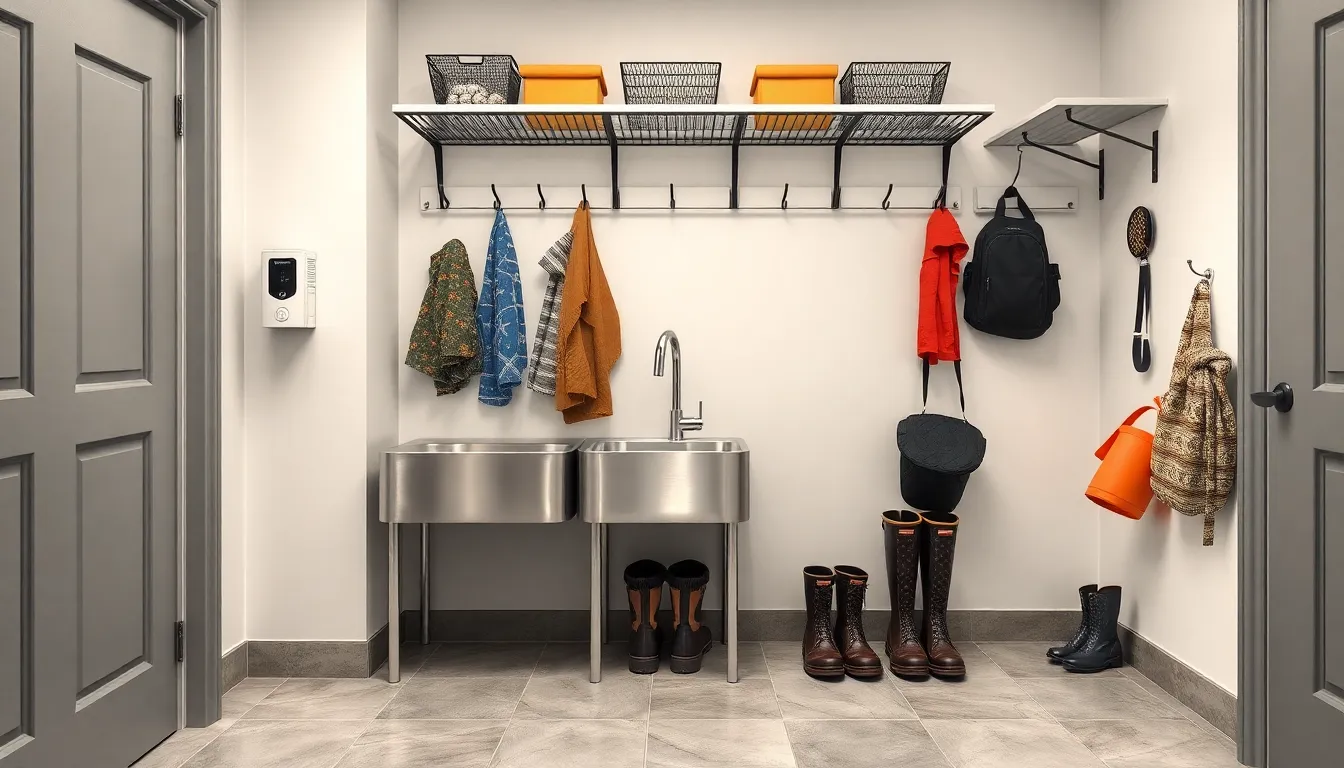
We’ll transform your mudroom into a more functional space by adding a washing station that handles all those dirty items before they enter your home.
Install a Utility Sink
Installing a utility sink creates the perfect spot for washing sports equipment, muddy boots, and other dirty items. We recommend placing the sink near your main entrance for easy access after outdoor activities. Deep basin sinks work best for cleaning larger items like soccer cleats and gardening tools.
Positioning the sink at the right height prevents back strain during use. Standard height ranges from 34 to 36 inches, but we suggest adjusting based on your family’s needs. Wall-mounted sinks save floor space while providing excellent functionality.
Choosing the right material ensures your sink withstands heavy use. Stainless steel resists stains and scratches, while composite materials offer durability and noise reduction. Both options handle frequent washing without showing wear.
Add Soap Dispensers and Towel Bars
Soap dispensers mounted near the sink enhance functionality and keep cleaning supplies organized. We prefer wall-mounted dispensers that hold enough soap for multiple washes without frequent refilling. Automatic dispensers reduce cross-contamination when handling dirty items.
Towel bars positioned within arm’s reach of the sink provide convenient drying options. Installing bars at different heights accommodates both adults and children using the washing station. Heated towel bars offer the added benefit of quick drying in humid conditions.
Storage for cleaning supplies keeps everything accessible yet organized. We recommend installing a small cabinet or shelf above the sink for detergents, brushes, and other cleaning tools. Open shelving works well for frequently used items like hand soap and scrub brushes.
Create Drying Space for Wet Gear
Drying racks prevent moisture buildup and keep wet gear organized after washing. We suggest installing wall-mounted racks that fold down when needed and tuck away when not in use. Stainless steel racks resist rust and handle heavy wet items like coats and boots.
Hooks positioned near the drying area provide additional hanging space for smaller items. Installing hooks at varying heights creates options for different gear types, from children’s rain jackets to adult work gloves. Heavy-duty hooks support wet items without bending or breaking.
Ventilation ensures proper air circulation around drying items. We recommend installing a small exhaust fan or ensuring adequate airflow from existing HVAC systems. Proper ventilation prevents mold and mildew while speeding the drying process.
Floor protection beneath the drying area prevents water damage. Installing a waterproof mat or choosing tile flooring in this section handles dripping water effectively. Slightly sloped floors toward a drain eliminate standing water and reduce slip hazards.
Use Vertical Wall Space for Maximum Storage
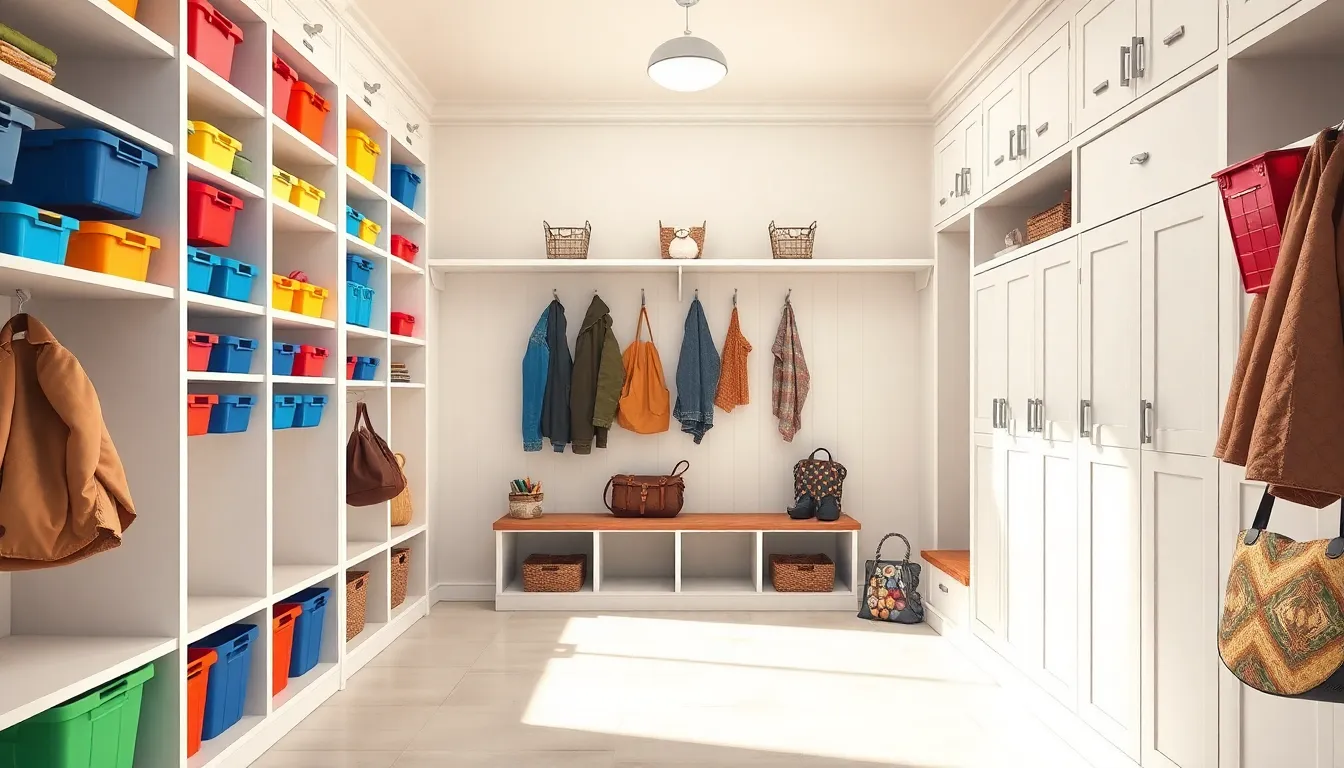
Maximizing your mudroom’s vertical space transforms every square inch into organized storage. We’ll show you how to use wall space effectively while maintaining easy access to daily essentials.
Install Floor-to-Ceiling Shelving
Floor-to-ceiling shelving maximizes storage capacity while keeping your mudroom floor completely clear for easy cleaning. We recommend installing adjustable shelves that can accommodate items of varying heights, from tall boots to small accessories.
Consider adding shelves with doors to hide visual clutter and maintain that tidy appearance we all desire in our entryways. Closed storage prevents dust accumulation on stored items and creates a streamlined look that enhances your mudroom’s overall aesthetic.
Position lower shelves within easy reach for frequently used items like lunch boxes and everyday bags. Upper shelves work perfectly for seasonal storage, housing items like winter coats during summer months or beach gear during colder seasons.
Install shelving units that extend from floor to ceiling to make the most of your available wall space. We suggest using sturdy materials like solid wood or metal brackets that can support the weight of heavy items without sagging over time.
Add Wall-Mounted Lockers
Wall-mounted lockers provide individual storage compartments that keep each family member’s belongings separate and organized. Each locker can house personal items like coats, backpacks, scarves, and other daily essentials without mixing up anyone’s gear.
Install lockers at appropriate heights for different family members, ensuring children can easily access their designated spaces. We recommend positioning lower lockers for kids while placing adult lockers at standard height for comfortable use.
Choose lockers with ventilation slots to allow air circulation, preventing moisture buildup that can lead to musty odors. Metal lockers offer exceptional durability and easy cleaning, while wooden options provide a warmer aesthetic that complements home decor.
Consider adding name labels or small chalkboards to each locker door for clear identification. This simple addition prevents mix-ups and helps maintain organization, especially in households with multiple children or frequent guests.
Create Display Areas for Seasonal Items
Open shelving creates attractive display areas that make seasonal items easy to find while adding visual appeal to your mudroom space. We suggest dedicating exact shelves to rotate seasonal decorations, sporting equipment, and weather-appropriate accessories.
Use decorative baskets or attractive bins to group similar seasonal items together, such as winter hats, gloves, and scarves during colder months. This grouping system keeps related items accessible while maintaining an organized, visually pleasing appearance.
Position seasonal displays at eye level where they’re most visible and easily reached when needed. Summer items like sunscreen, beach towels, and pool accessories can occupy prime real estate during warm months, then rotate to higher storage when seasons change.
Create themed sections that change throughout the year, showcasing holiday decorations, seasonal sports gear, or weather-exact accessories. This rotating display system keeps your mudroom feeling fresh and current while ensuring seasonal necessities remain within easy reach.
Design a Drop Zone for Daily Essentials
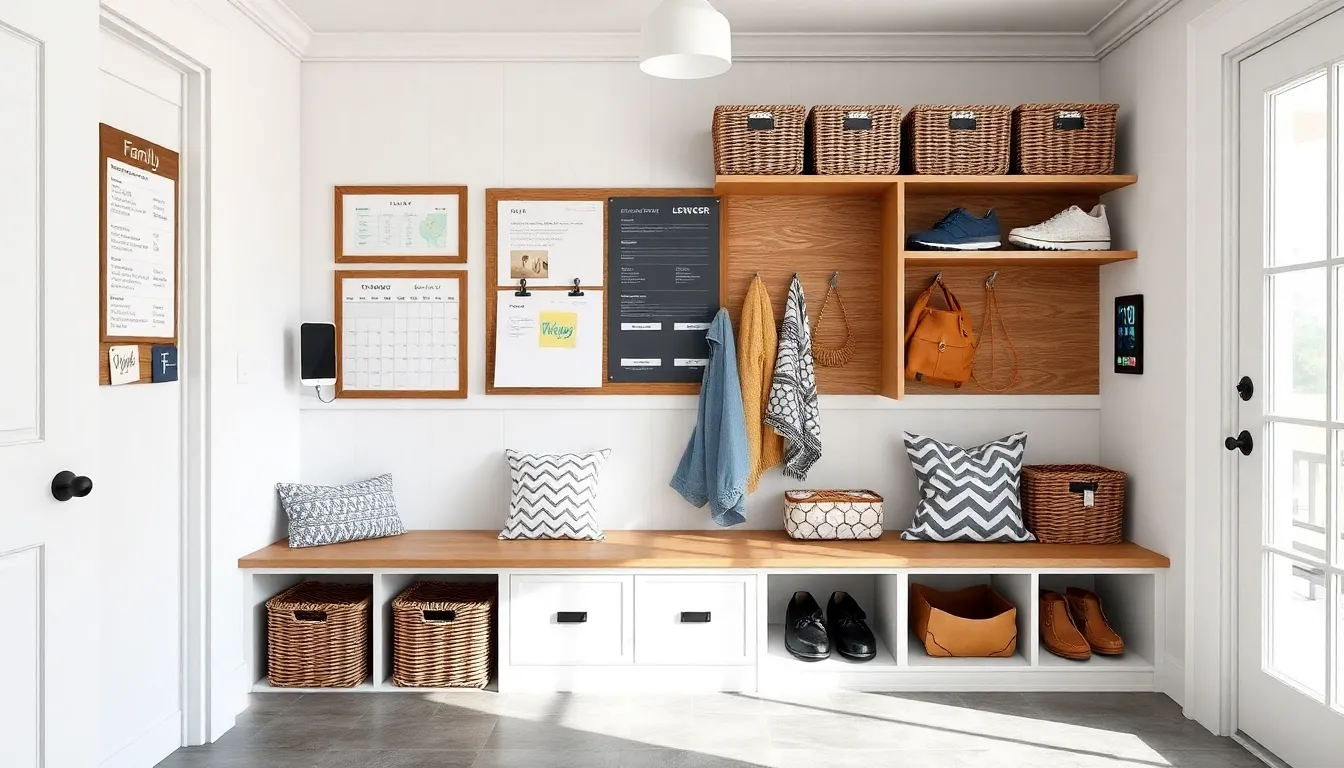
Creating an efficient drop zone prevents daily essentials from scattering throughout your home while establishing clear organization systems for busy families.
Create Charging Stations for Devices
Built-in charging stations keep electronic devices organized and powered up for daily use. We recommend incorporating USB ports directly into mudroom cabinetry or floating shelves to eliminate cord clutter and create dedicated charging spaces. Install electrical outlets at counter height to accommodate tablets, phones, and other portable devices without creating tangled wire displays.
Designated charging drawers provide hidden storage for devices while they power up overnight. Consider adding felt-lined compartments within these drawers to protect screens from scratches and organize multiple devices by family member. Built-in charging answers work particularly well when integrated into command center designs that combine storage with technology needs.
Add Calendar and Message Boards
Family command centers centralize scheduling and communication in one accessible location. We suggest mounting a large monthly calendar at eye level alongside cork boards or whiteboards for daily reminders and important messages. Magnetic boards offer versatility for holding documents, photos, and quick notes using decorative magnets that match your mudroom’s style.
Mail sorting systems complement message boards by providing designated slots for incoming correspondence, bills, and school papers. Install wall-mounted mail organizers with labeled compartments for each family member to prevent important documents from getting lost. Digital displays can replace traditional boards in tech-savvy households, showing shared calendars and family notifications through wall-mounted tablets.
Include Basket Storage for Quick Access
Wall-mounted baskets maximize vertical space while keeping frequently used items within easy reach. We recommend installing wire or wicker baskets at varying heights to accommodate different family members and seasonal accessories like hats, gloves, and scarves. Label each basket clearly to maintain organization and help family members return items to their proper locations.
Pull-out basket systems provide deeper storage capacity than fixed wall-mounted options while maintaining easy access to contents. These sliding mechanisms work particularly well for storing bulky items like sports equipment, cleaning supplies, or pet accessories. Choose baskets with ventilation holes to prevent moisture buildup and allow air circulation around stored items, especially important for damp gloves or wet gear.
Choose a Color Scheme That Hides Dirt
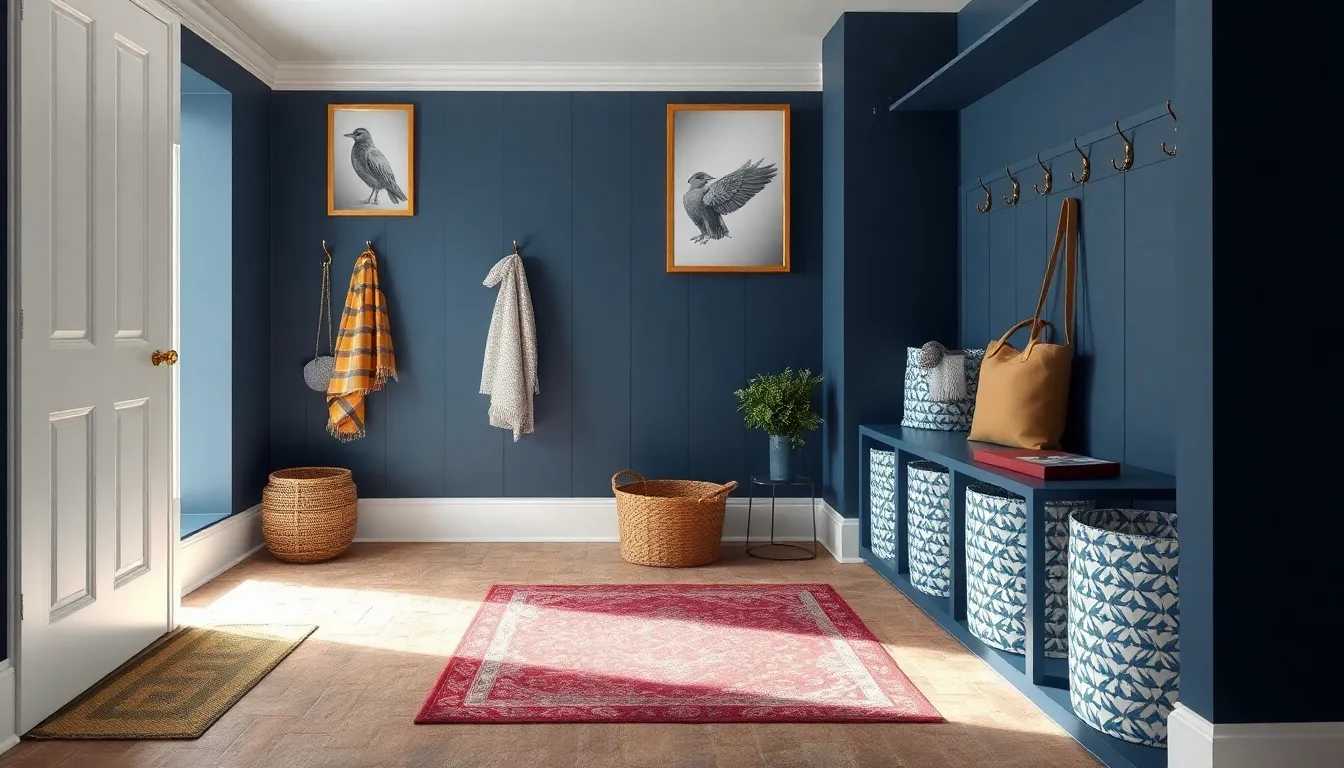
Smart color choices transform your mudroom from a maintenance nightmare into a low-upkeep sanctuary. Dark or deeper paint colors effectively conceal dirt, scuffs, and grime that accumulate in high-traffic areas.
Select Dark or Neutral Paint Colors
Dark paint colors reign supreme in mudrooms because they mask daily wear and tear with minimal effort. Deep blues, grays, and browns disguise footprints and mud streaks that would glare against lighter walls. Benjamin Moore Chelsea Grey delivers sophisticated depth while hiding scuff marks from bags and sports equipment. Farrow and Ball Downpipe creates an inviting atmosphere that doesn’t show every fingerprint or dust particle.
Neutral shades work exceptionally well in smaller mudrooms where darker colors might feel overwhelming. Light, airy neutrals can brighten compact spaces, but they require more frequent cleaning in busy households. We recommend testing paint samples in your exact lighting conditions since mudrooms often have limited natural light.
Use Patterned Materials Strategically
Patterned materials camouflage dirt better than solid surfaces while adding visual interest to your mudroom design. Herringbone brick floors combine durability with natural dirt-hiding properties, making scuff marks virtually invisible. Mosaic tile patterns disguise footprints and dust accumulation while creating texture that adds character to utilitarian spaces.
Subway tiles arranged in herringbone or basket weave patterns work particularly well for backsplashes behind washing stations. Wood grain patterns on vinyl flooring offer warmth and practicality, hiding scratches and wear marks that develop over time. Geometric wallpaper patterns can transform accent walls while concealing minor dings and marks from daily use.
Add Accent Colors Through Accessories
Accent colors breathe personality into dirt-hiding base schemes without compromising practicality. Storage bins in vibrant blues or greens add pops of color while keeping clutter contained and organized. Seasonal rugs introduce pattern and warmth while protecting floors from tracked-in moisture and debris.
Wall hooks in brass or copper finishes create focal points that draw attention away from inevitable wear patterns. Cushions on entry benches can showcase bold patterns or bright solids that complement your overall color scheme. We love switching out accessories seasonally to refresh the space without repainting walls or replacing major elements, giving you flexibility as your style preferences evolve.
Include Climate Control Features

We recommend incorporating climate control features to maintain optimal conditions year-round while protecting your mudroom from moisture-related damage. Smart thermostats and automated climate systems ensure consistent comfort for daily use.
Add Ventilation for Wet Items
Proper ventilation becomes critical when your mudroom frequently handles wet clothing, shoes, and outdoor gear. Installing exhaust fans helps circulate air and reduce humidity levels that can lead to mold growth.
Operable windows provide natural air circulation while allowing fresh air to enter the space. Ceiling-mounted drying racks offer space-saving answers that promote air circulation around damp items in combined mudroom-laundry layouts.
Strategic fan placement near storage areas accelerates the drying process for wet boots and rain gear. We suggest positioning exhaust fans to create cross-ventilation patterns that draw moisture away from storage zones.
Install Heating Elements
Radiant floor heating systems provide even heat distribution throughout your mudroom during colder months. Wall-mounted heaters offer targeted warmth that makes the space more pleasant for family members.
These heating answers help dry wet items more quickly while maintaining comfortable temperatures for daily activities. Electric baseboard heaters work well in smaller mudrooms where radiant systems aren’t feasible.
Programmable heating controls allow you to adjust temperatures based on usage patterns and seasonal needs. Timer settings ensure energy efficiency while providing warmth when your family needs it most.
Consider Dehumidification Options
Dehumidifiers prevent mold and mildew buildup in high-moisture mudroom environments where wet gear is stored regularly. Energy-efficient models with automatic humidity sensors maintain consistent indoor air quality without constant monitoring.
Selecting units with built-in drainage systems eliminates the need for frequent water tank emptying. Whole-house dehumidification systems integrate seamlessly with existing HVAC equipment for comprehensive moisture control.
Portable dehumidifiers offer flexibility for seasonal use or exact problem areas within your mudroom layout. We recommend units rated for your mudroom’s square footage to ensure adequate moisture removal capacity.
Conclusion
Creating the perfect mudroom doesn’t have to be overwhelming when you break it down into manageable components. We’ve shown you how strategic planning and smart design choices can transform even the smallest spaces into highly functional entry points that serve your family’s needs.
The key lies in combining practical storage answers with durable materials that can withstand daily wear and tear. From custom cubbies and built-in benches to smart lighting and climate control features you’ll find that investing in quality components pays off in long-term functionality.
Remember that your mudroom should work specifically for your family’s lifestyle and routines. Whether you’re dealing with sports equipment wet boots or daily essentials the right combination of storage answers will keep your home organized and welcoming.
Start with one or two key improvements and build from there. Your future self will thank you for creating a space that truly works.
Frequently Asked Questions
What is the main purpose of a mudroom?
A mudroom serves as a transition space between the outdoors and your home’s interior, preventing dirt, mud, and clutter from spreading throughout the house. It provides organized storage for shoes, coats, bags, and other daily essentials while offering a designated area to clean up before entering the main living spaces.
What materials work best for mudroom entry benches?
Weather-resistant materials like solid wood, marine-grade plywood, and powder-coated metal frames offer the best durability for mudroom benches. These materials can withstand moisture and heavy use. Adding outdoor fabric cushions with quick-dry foam inserts and removable covers enhances comfort while ensuring easy maintenance and cleaning.
How should I size cubbies for different family members?
Cubbies should be tailored to each family member’s needs and height. Children’s cubbies should be lower and smaller, while adult cubbies need more height for longer coats. Generally, allow 12-15 inches wide per person, with heights ranging from 48 inches for children to 60+ inches for adults. Include adjustable shelving for flexibility.
What type of flooring is best for mudrooms?
Durable tile options like porcelain or ceramic work best for high-traffic mudrooms, offering water resistance and easy cleaning. Vinyl flooring provides a practical, budget-friendly alternative. Choose materials that handle moisture well and consider floors with subtle slopes toward drains for better water management in wet conditions.
How can I maximize storage in a small mudroom?
Utilize vertical wall space with floor-to-ceiling shelving and wall-mounted hooks at varying heights. Install cubbies with built-in storage underneath benches, add pull-out baskets for easy access, and use wall-mounted organizers for keys and mail. Consider fold-down or retractable elements to save space when not in use.
What lighting works best in mudrooms?
Motion-sensor overhead lights provide hands-free convenience and energy efficiency. Add task lighting at bench level using under-bench LED strips or battery-powered lights for areas without electrical access. Maximize natural light through skylights or larger windows, and use light-colored paint to enhance brightness throughout the space.
Should I include a washing station in my mudroom?
A utility sink near the main entrance is highly beneficial for washing dirty sports equipment, muddy boots, and other items before they enter your home. Choose durable materials like stainless steel or composite, and include soap dispensers, towel bars, and storage for cleaning supplies to create a complete washing station.
How can I control moisture and humidity in my mudroom?
Install exhaust fans and ensure proper ventilation through operable windows. Consider dehumidifiers to prevent mold and mildew, especially in humid climates. Add drying racks for wet gear, ensure adequate air circulation around storage areas, and choose moisture-resistant materials for flooring and storage components to maintain optimal conditions.

